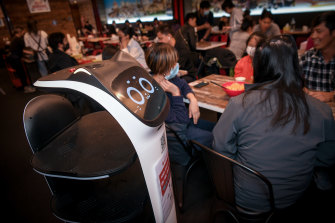There are no questions possible of the robot, such as “where is the rest of my food?” Table 16 has this exact issue, with one person’s dish missing and the attention of a human staff member needed to check where it is.
Eventually, the pad thai arrives, however the Bellabot is blissfully unaware of any problems, having already moved on to ferrying someone else’s lunch.

The robots deliver food, with other jobs left to human staff.Credit:Eddie Jim
The robots are not cheap, costing $24,000 to buy, although there is a rental option for $48 per robot per day (far less than the minimum wage). And while they are somewhat limited in what they can do, one thing they do bring is a novelty factor lapped up by smartphone camera-toting diners.
The rise of this AI workforce may have consequences for the future of industrial relations, however not all the jobs at Dodee Paidang have been taken over by robots.
There are still plenty of people doing the other tasks required to keep a busy food operation running, like ferrying drinks, wiping tables and clearing plates.
Dodee Paidang owner Boon Low said he needed to re-evaluate how his restaurant operated after it was badly affected by the lockdowns, which hurt CBD hospitality businesses more than most.

Boon Low , co-owner of DoDee Paidang.Credit:Simon Schluter
“Our restaurant is a volume restaurant, so it needs people because at the prices that we sell our food, we need volume to turn a profit,” he said.
Mr Low said the reason for introducing the robots was to allow staff to focus on more valuable tasks that need attention at his restaurant.
Loading
“We need to value people’s time more and more, we’re under a lot of pressure as a business to keep our prices stable or low and pay our staff well,” he said.
“People’s expectation of what they want to pay and what the actual cost is doesn’t normally equate.”
Innovation in the form of robot waiters was something that Mr Low expected to see more of in hospitality as owners look for ways to keep costs down.
If he could, he would bring in other robots to do similarly repetitive jobs like dishwashing or food prep, he said.
Credit: Source link





















